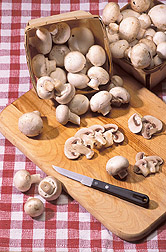This page has been archived and is being provided for reference purposes only. The page is no longer being updated, and therefore, links on the page may be invalid.
|
|
Nutrient Data on Mushrooms Updated
By Rosalie Marion BlissAugust 18, 2006
Mushrooms contain several key nutrients, including copper, potassium, folate and niacin, according to recently analyzed nutrient data. Seven varieties of mushrooms—white button, oyster, shiitake, enoki, portabella, crimini and maitake—were analyzed to create a unique nutrient profile for each.
The project was coordinated by Agricultural Research Service (ARS) lead nutritionist David Haytowitz, located at the Beltsville (Md.) Human Nutrition Research Center (BHNRC). Haytowitz is with the BHNRC’s Nutrient Data Laboratory (NDL). The research was funded in part by the Mushroom Council of Dublin, Calif.
Mushrooms were collected from retail outlets around the country to get a nationally representative sampling. The mushroom varieties were analyzed for fat, fiber, protein, carbohydrate, vitamins and minerals, and for ergosterol, a precursor to vitamin D.
While most varieties were analyzed raw, white button mushrooms, which are commonly used in recipes, were also analyzed after stir-frying and microwaving to gauge the levels of nutrients retained after cooking. Adding to existing data, portabella mushrooms were analyzed after grilling, and shiitake mushrooms were analyzed after stir-frying. Most nutrients were found to be fully retained when cooked, while others were retained at between 80 and 95 percent of their levels in raw mushrooms.
All of the mushrooms were found to provide a significant amount of copper. Each cup of stir-fried white button mushrooms provides 0.3 milligram of copper, which is about one-third of the recommended daily intake for adults. Copper helps the body produce red blood cells and drives a variety of chemical reactions that are key to human health.
The mushrooms also provide a significant amount of potassium, a mineral that helps the body maintain normal heart rhythm, fluid balance, and muscle and nerve function. Two-thirds of a cup of sliced, grilled portabella mushrooms contains the same amount of potassium as a medium-sized banana.
The new nutrient values for mushrooms will appear in this year's update to the NDL- managed USDA National Nutrient Database for Standard Reference, Release 19, available soon at www.ars.usda.gov/nutrientdata/.
ARS is the U.S. Department of Agriculture's chief scientific research agency.

